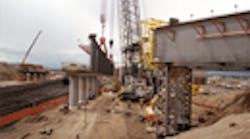A broad coalition of industry groups, state Governors, members of Congress, and public works experts are pushing the federal government to create a National Infrastructure Bank (NIB) to increase and speed up investments in regional and national infrastructure projects.
Transportation projects, in particular, are being touted as ideal candidates for NIB funding – largely because such a national financing entity would allow for more consistent funding instead of the “piecemeal” approach typically used today.
“There’s a growing gap between our highway needs and our investments to meet them,” Jack Basso, COPO of the American Assn. of State Highway and Transportation Officials (AASHTO), told FleetOwner . “On top of that, states are tight for money right now, so a ‘bank’ would gives us the ability to capitalize projects on credit for the long term, rather than wait every year to see if we have money in the state budget to continue it.”
Basso and others gathered last week on Capitol Hill to promote the NIB concept to Congress and the Obama Administration. The thinking is the special bank would have the authority to employ a range of finance and funding tools for a variety of infrastructure projects, including highways, ports, rail (freight and passenger), drinking and waste water needs, the electrical grid, and broadband Internet networks and schools.
U.S. Rep. Rosa DeLauro (D-CT) introduced the National Infrastructure Development Bank Act last week to establish such an independent fiscal entity to, in her words to “objectively leverage significant investment into the transportation, environmental, energy and telecommunications infrastructure.”
If created, the bank would use grants, credit assistance, low-interest loans and tax incentives to fund infrastructure projects; encourage project sponsors to identify new revenue streams to leverage costs; promote more efficient governance, and spur further innovation.
“America needs a variety of methods – action by the government and private sector, current and new revenues, and federal leadership and local innovation – to repair and modernize our nation’s infrastructure,” said Pennsylvania Gov. Ed Rendell (D), who serves as c-chair of “Building America’s Future,” the group that sponsored the Captiol Hill event.
“The NIB should play a role as a funding and financing vehicle for projects that have major national or regional impact,” Rendell added. “This is an important reform that is urgently needed to address our nation’s infrastructure funding shortfalls.”
“In this era of constrained finances and mounting needs on a national scale, the Infrastructure Bank would spur innovation in funding large-scale transportation projects critical to job creation and to our future economy,” said James Corless, director of Transportation for America. “Because projects would compete based on merit, it would help to select the investments that do the most to advance our national goals, whatever the mode: rail, highway, ports or public transportation.”
AASHTO’s Basso said one of the key reasons for establishing the NIB would be the creation of a perpetuating “cycle” of monies generated from the economic activity spurred by big infrastructure projects to replenish the bank’s source of funding.
“The key is the revenue stream – we’d be able to create a revolving source of funding instead of relying on just one-time-only grants,” he explained. “Let’s say you institute a dedicated sales tax to pay for a highway network in a certain region. That tax money builds the highway, but as business relocates to take advantage of the new highway network – with factories, distribution centers, etc. – you generate more sales, thus increasing the funds flowing [back] into the bank.”
Basso stressed that this is one of only one of several potential funding mechanisms for the NIB; indeed, even “Building America’s Future” does not have an official position on one funding source over another. But he noted that infrastructure can no longer continue to be underfunded in the U.S., especially when it comes to transportation networks.
“Everything in manufacturing is based on JIT [just-in-time] delivery, so delays due to congestion or poor roads means plants have to shut down – and that costs money,” Basso said. “Uncertainty in freight movements kills manufacturing – forcing companies to relocate to places with more dependable networks.
“That’s why we need to open up a broader stream of funding options to maintain, improve, and expand our infrastructure in this country,” he added.




